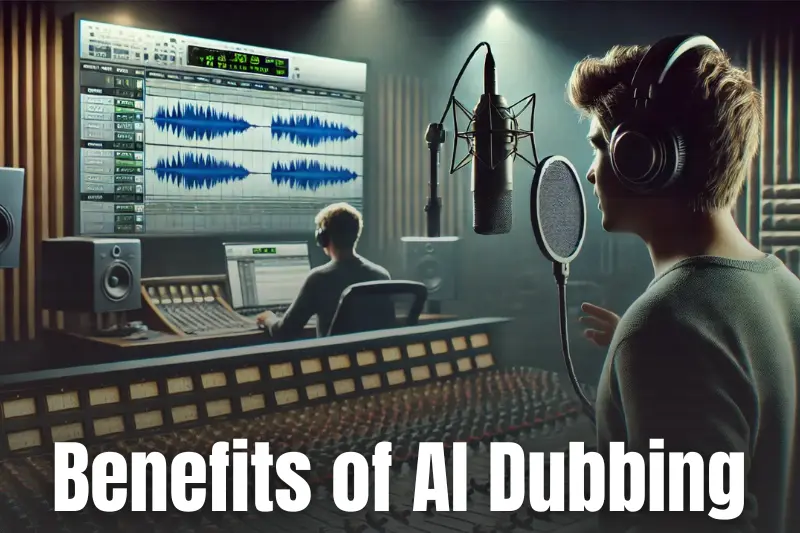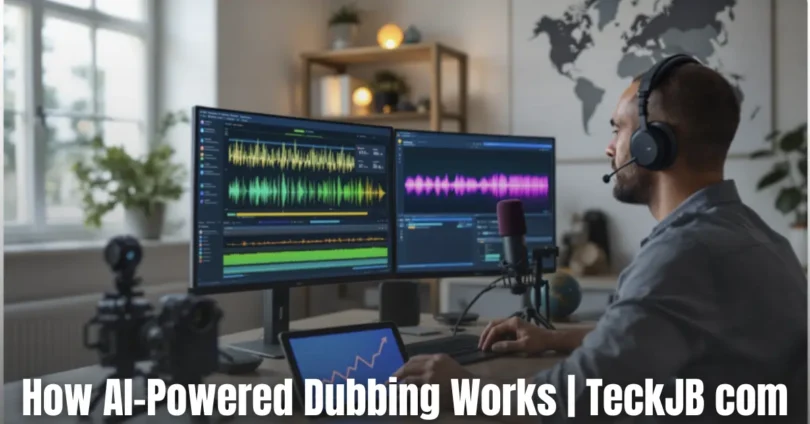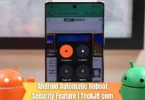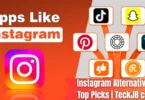Ever watched a video where the speaker’s voice suddenly changes to your language—like magic? That’s dubbing. But today, thanks to technology, dubbing has become smarter and faster. Wondering how AI-powered dubbing works? It’s all about using artificial intelligence to copy voices, translate speech, and match it with the speaker’s lip movements.
In this post, we’ll break down how AI-powered dubbing works in simple steps. No tech jargon. Just easy-to-understand facts, real-life examples, and helpful tips!
What Is AI Dubbing?

AI dubbing means using artificial intelligence to change the voice in a video into another language—automatically.
It saves time, money, and makes videos easier to share worldwide.
Here’s what makes it special:
It Uses Machine Learning
AI listens, learns, and improves over time just like humans.
- AI systems are trained with thousands of voice samples.
- They learn how people talk, including tone and pitch.
- The more data it gets, the better and more natural the voice sounds.
It Can Copy Human Voices
AI can create a voice that sounds just like the original speaker.
- It mimics tone, speed, and emotion.
- Viewers feel like the person is really speaking their language.
- Some tools even keep the speaker’s unique voice in other languages.
It Translates Speech Automatically
AI can understand and translate spoken words into any language.
- It changes spoken words into text first.
- Then, it translates that text using smart algorithms.
- Finally, it turns the translated text back into speech.
It Matches Voice with Lip Movements
AI makes the new voice fit the speaker’s lips and timing.
- This is called “lip-syncing.”
- It makes the video look more natural and real.
- Some AI tools even adjust facial expressions to match the new language.
You may also like it:
Personal Finance Guide: Tips for Financial Success
Smart Home Trends: Top Innovations for 2025
Easy Budgeting Tips: Manage Your Money Smartly
Key Technologies Behind It
AI dubbing uses a mix of smart tools and systems to understand, translate, and speak like a human.
Here are the main technologies that make it possible:
Speech Recognition
This helps AI understand and turn spoken words into text.
- It listens to the speaker’s voice and breaks it down into words.
- It removes background noise and focuses on the main speech.
- This step is important before translating or changing the voice.
- Tools like Google Speech-to-Text use this technology.
Natural Language Processing (NLP)
NLP allows AI to understand the meaning of the words.
- It checks grammar, sentence flow, and tone.
- It helps the AI translate the speech accurately.
- It makes sure the final message makes sense in another language.
- NLP is what makes AI sound human, not robotic.
Machine Translation
This lets AI translate one language into another, fast and smart.
- It changes the text from one language to another.
- It keeps the original meaning and emotion.
- It handles different accents, phrases, and expressions.
- Tools like DeepL and Google Translate use this tech.
Text-to-Speech (TTS)
TTS turns the translated text back into speech.
- It creates a clear and natural-sounding voice.
- Some systems can clone the original speaker’s voice.
- It adjusts the speed, tone, and pause to sound real.
- TTS is what gives AI dubbing its final voice output.
Lip-Sync Technology
This makes the speaker’s lips match the new audio perfectly.
- It adjusts mouth movements to fit the new language.
- It helps the video feel smooth and believable.
- Advanced AI tools even match facial expressions.
- Viewers feel like the speaker is actually speaking their language.
How the Process Works
AI dubbing follows a smart, step-by-step process to change the voice in a video into another language.
Each step uses different tools to make the final result smooth and natural.
Step 1: Audio Is Collected and Analyzed
The AI starts by listening to the original speech in the video.
- It takes the audio from the video or voice recording.
- The system filters out noise and focuses on clear speech.
- It identifies where each sentence begins and ends.
- This helps prepare the voice for transcription.
Step 2: Speech Is Converted to Text
The spoken words are turned into written text using speech recognition.
- AI listens to the speaker’s voice and types it out.
- It understands words, pauses, and punctuation.
- This step is important before translation can begin.
- The result is an accurate script of what was said.
Step 3: Text Is Translated Into a New Language
Now the AI takes the text and translates it to another language.
- It uses natural language processing (NLP) and translation tools.
- The goal is to keep the meaning, tone, and style the same.
- It avoids direct word-for-word translation to sound natural.
- This step ensures the message fits the target language well.
Step 4: New Voice Is Created
The translated text is turned back into speech using text-to-speech (TTS) tools.
- AI generates a human-like voice in the new language.
- It can match the original speaker’s tone or create a new one.
- The voice is clear, smooth, and sounds natural.
- The speed and emotion are adjusted to feel real.
Step 5: Voice Is Synced with the Video
AI matches the new voice with the speaker’s lip movements and timing.
- Lip-sync tools adjust the video so the lips match the new audio.
- Some systems also adjust facial expressions.
- Timing is fine-tuned to make everything look natural.
- This final step makes the video feel like it was recorded in the new language.
Real-World Use Cases
AI-powered dubbing is already helping many industries reach a global audience.
It makes content easy to understand in different languages and saves time.
Streaming Services
Platforms use AI dubbing to offer shows and movies in many languages.
- Netflix, Amazon Prime, and others use AI to dub shows quickly.
- Viewers can enjoy content in their own language without subtitles.
- It helps reach more people across the world.
- It saves production time compared to manual dubbing.
Online Education
E-learning platforms use AI to teach global students in their native language.
- Websites like Coursera and Udemy use AI dubbing for international learners.
- Instructors can reach students without re-recording lessons.
- It helps students understand better and stay focused.
- It improves learning for people in non-English speaking countries.
Social Media and Content Creators
Creators use AI to reach global followers by dubbing their videos.
- YouTubers and influencers use it to share content with global audiences.
- It helps videos go viral in different regions.
- Dubbing short-form content like Reels or TikToks becomes quick and easy.
- Creators don’t need to speak multiple languages.
Business and Marketing
Companies use AI dubbing for ads, product demos, and customer training.
- Businesses can localize their content fast and at low cost.
- Product videos, tutorials, and ads can be dubbed into many languages.
- It helps brands connect with customers around the world.
- Sales teams can train staff in different regions without language issues.
Gaming and Animation
Game developers use AI to voice characters in many languages.
- Characters in games can speak any language with real emotion.
- AI dubbing saves time when creating global versions of games.
- Players get a better experience with voiceovers in their native tongue.
- Animated movies and series can be released faster in multiple regions.
Benefits of AI Dubbing

AI dubbing offers many advantages for creators, businesses, and viewers.
It saves time, reduces cost, and helps content reach more people worldwide.
Faster Production
AI dubbing takes minutes, not weeks, to create voiceovers.
- Traditional dubbing needs actors and studios, which takes time.
- AI can process and dub long videos in a short time.
- It’s perfect for fast-moving industries like news or social media.
- Creators can release content quicker than ever.
Lower Cost
It reduces the need for studios, voice actors, and translators.
- You don’t need to hire people for every language.
- AI does most of the work, cutting project costs.
- Small creators and startups can afford high-quality dubbing.
- Budget-friendly tools are now available online.
Scalable for Many Languages
AI can dub content into dozens of languages at once.
- You can reach global audiences without re-recording.
- Tools can support over 50+ languages and accents.
- It’s great for international platforms or online businesses.
- More reach means more views, sales, or sign-ups.
Keeps the Speaker’s Original Style
Some AI tools can copy the speaker’s voice, tone, and emotion.
- It feels like the original person is still speaking.
- The audience connects better with the message.
- This is useful for public figures, influencers, and brand voices.
- It makes videos feel natural and trustworthy.
Easy to Edit and Update
If something changes, AI dubbing can quickly update the voice.
- You don’t have to re-record the whole video.
- Just change the script or audio and re-run the dubbing tool.
- Saves time on updates or corrections.
- Helps keep content fresh and up-to-date.
Limitations and Challenges
AI dubbing is powerful, but it’s not perfect yet.
There are still some issues that creators and users should know.
Voice May Sound Robotic
Some AI voices still lack natural emotion and flow.
- It can feel flat or unnatural in emotional scenes.
- Listeners might notice a difference from real human speech.
- Humor, sadness, or excitement may not come through clearly.
- Viewers may lose interest if the voice feels too fake.
Translation Isn’t Always Accurate
AI may miss the meaning behind certain words or phrases.
- It can struggle with slang, idioms, or cultural terms.
- Some sentences may be translated too literally.
- This can change the meaning or confuse the viewer.
- Human review is still needed in many cases.
Lip-Sync May Not Be Perfect
Matching mouth movements in different languages is still a challenge.
- Different languages have different word lengths.
- Some words don’t fit well with the speaker’s original lips.
- Small timing errors can make the video look odd.
- It may break the viewer’s focus or feel unnatural.
Limited Emotion and Tone Control
AI can’t always adjust voice tone perfectly for every scene.
- A serious moment may sound too casual, or vice versa.
- It’s hard to match deep emotions like anger or joy.
- Some tools don’t let you fine-tune pitch or energy.
- This can hurt the impact of your message.
Data Privacy and Security Concerns
Using AI tools means uploading voice and video data online.
- Your content might be stored or reused without notice.
- Some free tools don’t protect user data well.
- It’s risky for sensitive or private content.
- Always check the privacy policy before using any tool.
Future of AI in Dubbing
AI dubbing is getting better every day—and the future looks even more exciting.
More tools, better voice quality, and smarter translations are on the way.
More Human-Like Voices
AI will sound even more real and emotional in the future.
- Voices will express feelings like joy, fear, or sadness more naturally.
- Listeners may not be able to tell if it’s AI or a real person.
- This will improve storytelling and viewer connection.
- It’s great news for creators who want to keep things personal.
Real-Time AI Dubbing
Dubbing could happen live during videos, meetings, or calls.
- Live dubbing helps with global events, webinars, or interviews.
- It breaks language barriers instantly while you speak.
- AI will process, translate, and speak in real-time.
- This could change the way we talk across borders.
Better Language and Accent Support
AI will support more languages, dialects, and local accents.
- Users will get dubbing that feels truly local.
- Regional slang and phrases will be handled better.
- It can help brands connect with specific communities.
- AI will learn cultural tone and context too.
Easy Tools for Everyone
AI dubbing tools will become easier for anyone to use.
- No need for tech skills or expensive software.
- Creators can dub videos with just a few clicks.
- Mobile-friendly apps may offer dubbing on the go.
- Small businesses and solo creators can go global.
Ethical and Secure Dubbing
There will be more focus on safety, privacy, and fair use.
- AI tools will follow rules to protect your data.
- Voice cloning will need proper consent and control.
- Creators will get more rights over how their voice is used.
- Safe AI will build trust and reduce misuse.
Conclusion
AI dubbing is changing the way we share content across the world. It makes videos easier to understand in many languages—faster and cheaper than ever. While there are still a few challenges, the future looks bright.
As the technology grows, creators, businesses, and learners will all benefit. So, if you want to reach a global audience, AI-powered dubbing is the smart way to do it.
FAQs About How AI-Powered Dubbing Works
Here are some common and simple questions people ask about how AI-powered dubbing works:
What is AI-powered dubbing?
AI-powered dubbing is when artificial intelligence changes the voice in a video to another language while keeping it in sync with the speaker’s mouth.
How is AI dubbing different from traditional dubbing?
AI dubbing is faster, cheaper, and doesn’t need voice actors or recording studios. The software does most of the work automatically.
Is AI dubbing accurate?
Yes, it’s pretty accurate. But sometimes it may miss small details or emotions. Some human editing can make it better.
Can AI match the speaker’s voice and tone?
Yes. Some advanced AI tools can copy the speaker’s voice, tone, and even emotions to make it sound more natural.
How long does it take to dub a video with AI?
It depends on the video length, but usually, AI can dub a full video in just a few minutes.
What types of content can I dub with AI?
You can use it for YouTube videos, online courses, ads, podcasts, interviews, and more.
Is AI dubbing safe to use?
Yes, but always use trusted tools. Check their privacy policy to make sure your data is protected.
Bonus Points
- Supports Multiple Content Types: AI dubbing works for movies, ads, tutorials, podcasts, and more without needing different tools.
- Saves Human Effort: It reduces the need for hiring multiple voice actors, editors, or translators for every language.
- Improves Accessibility: People with hearing difficulties can pair dubbed audio with subtitles in their own language.
- Boosts Global Reach: Dubbing in local languages helps content go viral in international markets.
- Enhances User Experience: Viewers enjoy native-language audio instead of reading subtitles, which feels more engaging.
- Works on Older Content Too: You can dub old videos and give them new life in different languages.
- Fast Turnaround Time: Long videos can be dubbed in just a few minutes with the right tools.
- Custom Voice Options: Some AI tools let you pick different voice tones—male, female, energetic, calm, etc.
- Low Setup Required: No need for a studio or high-end mic—just upload your video and let the AI work.
- Easily Scalable for Businesses: Companies can dub training, support, and marketing content across all regions without extra teams.
You may also like it:
Saving Money Tips for Students: Master Your Finances Now!
Startup Marketing Strategies: Boost Your Business Fast







